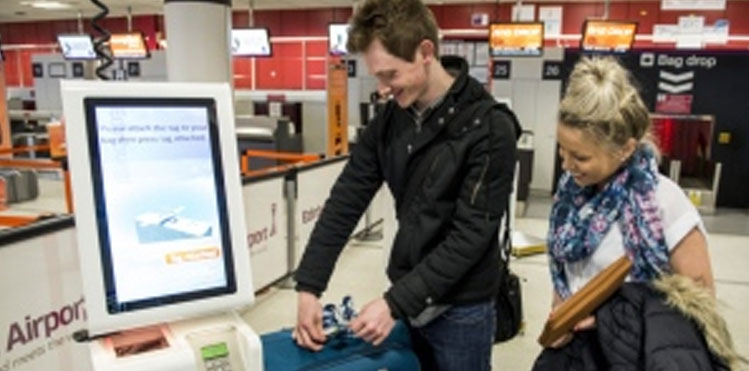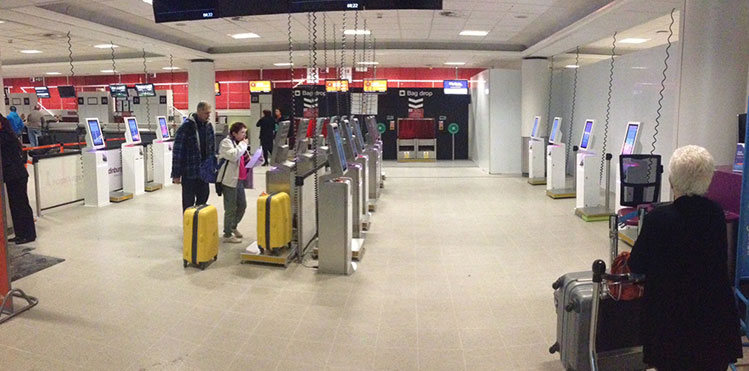
Lawrence Eke, Managing Director, Phase 5 Technology: “Common-use is a very important factor, and has always been at the heart of our solutions. People flying with easyJet, Flybe, and Ryanair from Edinburgh Airport enjoy a radically improved passenger experience, as they don’t have to queue to drop a bag.”
Edinburgh Airport is firmly committed to delivering the best possible passenger experience. This is perhaps most visible in the check-in process. In partnership with Phase 5 Technology, the airport has introduced a multi-airline bag drop facility. The 24 self-service kiosks allow passengers to weigh their baggage and print their own bag tag.
Lawrence Eke, Managing Director, Phase 5 Technology, explained that the company spent five years making its self-service kiosks as easy to use as possible. The process has as few as three steps – weigh, scan, and tag. A large 18-inch screen guides the passenger through the process using large text and animations. The text automatically changes to the preferred language of the passenger using the information in their booking; 31 languages are currently available. “There are no complex multiple-choice questions, and at Edinburgh passengers aren’t required to touch the screen,” Eke commented. “Most passengers complete the process in 30 seconds, with some completing it in under 20 seconds. Our fastest-ever transition was recorded at Edinburgh Airport by a Ryanair passenger completing the process in just 12 seconds!”
Edinburgh Airport was the first in the UK to use web-based software to operate a fully common, shared bag drop facility for passengers. It is a solution that Eke explained has several advantages over Common-Use Self-Service (CUSS). “We decided that we wanted to provide airports and airlines with solutions, not CUSS applications they had to develop, certify, deploy and manage, all at considerable cost,” he explained. “We wanted the flexibility to develop the solution around the problem to be solved, not the CUSS standard. We wanted to use a large 18-inch touchscreen, Windows 8 (soon Windows 10), PCI-compliant common-use payment services via chip and PIN, and a range of other hardware and software that would have been prohibited by CUSS. We wanted the solution to be web-enabled to allow integration with third party systems and future-proof the solution for when new technological developments arise.”

Phase 5 Technology’s innovative self-service kiosks allow passengers to weigh their baggage and print their own bag tag. The process has as few as three steps – weigh, scan, and tag. A large 18-inch screen guides the passenger through the process using large text and animations.
Phase 5 Technology has been developing the IATA Common-Use Web Services (CUWS) standard with other work group members to provide a common messaging standard for airport systems to exchange information with airline systems. This means any compliant airline can use any complaint airport system without any integration. “IATA CUWS negates the need for individual airline applications and the CUSS platform to support them,” Eke said. “SONIC Bag Drop and IATA CUWS provide a viable, cost-effective, modern alternative and remove the dependency on individual airline applications.”
‘Common-use at the heart of our solutions’
At Edinburgh Airport, the multi-airline SONIC Bag Drops successfully process thousands of passengers, bags and payments on a daily basis. The common-use area supports three airlines, accessing three different systems, and operated by two different ground handlers. “We believe this is the first multi-airline, multi-handler, multi-DCS, self-service bag drop operation in Europe, and perhaps the world,” Eke noted.

At Edinburgh Airport, the multi-airline SONIC Bag Drops successfully process thousands of passengers, bags and payments on a daily basis. The common-use area supports three airlines, accessing three different systems, and operated by two different ground handlers.
SONIC Bag Drops enable the airport to increase efficiency by making better use of the terminal’s real estate. This is achieved though several features, most significantly self-service and common-use. Self-service allows all units to be available all of the time, and the SONIC Bag Drop kiosks are only 30cm wide, meaning they are space-efficient.
“Common-use is a very important factor, and has always been at the heart of our solutions,” Eke added. “People flying with easyJet, Flybe, and Ryanair from Edinburgh Airport enjoy a radically improved passenger experience, as they don’t have to queue to drop a bag.”
Phase 5 Technology is also ready for when permanent bag tags catch on, and looks forward to airlines making use of this new technology. “Realistically, I think it could be a while before we see the majority of passengers using this type of bag tag, but it’s certainly an exciting idea,” Eke enthused. “We have tested various forms of near-field technologies and are following the evolving standards. We think there will always be situations when a physical bag tag is required, although I imagine smart luggage will only improve. We continue to develop and test the SONIC TouchTag so it remains the simplest, most functional, cost-effective self-adhesive bag tag.”
One-step or two-step?
Eke believes the debate surrounding whether a one-step or two-step solution is most effective is “circular, insular and most frustrating”. “The passenger does not care about one-step or two-step,” he said. “The passenger only cares about completing the bag drop process and going airside. We, therefore, believe that you have to enable the passenger to complete the process however they arrive at the bag drop. At Phase 5 Technology we like to call this ‘all-step’.”
He added: “If the passenger misses step one, don’t send them away! Just help them get their boarding pass, bag tag and drop. If the passenger has already tagged their bag, accept it! If the passenger needs to pay, take the payment! If the passenger needs to add their passport details, add them via a scanner!”
The most important thing is to be able to process passengers however they arrive. “As more airports implement the Edinburgh model, they too will realise that multi-airline processing makes the one-step/two-step question an irrelevance,” Eke concluded.







